Younger Two & Older Two Years
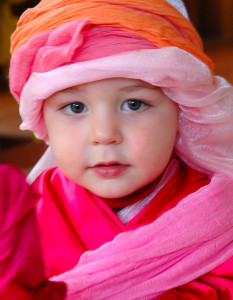 Background: The Gesell Institute of Child Development has observed that children go through a repeating sequence of six different stages with predictable changes in mood and behaviour in each. The behavior observed in these stages reflects the qualities associated in tradition with the planets. There are two stages lasting 6 months within this one year, reflecting the qualities of first Moon and then Mercury. The developmental traits in these profiles represent only one aspect of children’s behaviour and may be masked, modified or intensified by other factors, both individual and environmental, such as temperament, gender related behaviours, high stress levels, over-stimulation, too much screen time (TV, video, computers, tablets, etc) or organic problems.. Note: If your child has turned a particular age but shows none of these behaviours, please read the previous age level, or just wait a few months, then read this again!
Background: The Gesell Institute of Child Development has observed that children go through a repeating sequence of six different stages with predictable changes in mood and behaviour in each. The behavior observed in these stages reflects the qualities associated in tradition with the planets. There are two stages lasting 6 months within this one year, reflecting the qualities of first Moon and then Mercury. The developmental traits in these profiles represent only one aspect of children’s behaviour and may be masked, modified or intensified by other factors, both individual and environmental, such as temperament, gender related behaviours, high stress levels, over-stimulation, too much screen time (TV, video, computers, tablets, etc) or organic problems.. Note: If your child has turned a particular age but shows none of these behaviours, please read the previous age level, or just wait a few months, then read this again!
These profiles integrate the wonderful descriptions from the Gesell Institute of Child Development research, and the ideas of Rudolf Steiner into my own research. Direct quotations from the Gesell Institute’s books are in ‘single quote marks’.
View/download pdf Two
Younger Twos: Two to Two Years & 6 months
A stage with Moon qualities
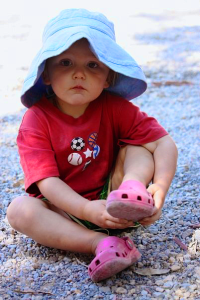 In Younger Twos we see qualities and motivations traditionally associated with the Moon with the importance to them of love and relationships—children of this age are relatively more amenable, sympathetic, sociable and non- confrontational; they are home loving and happy to live in the present; they like an ordered world and are conservative by nature. All this contrasts greatly with the nature of Older Twos (with Mercury qualities) in the next stage. The stage of Younger Twos is described by the Gesell Institute researchers as being in ‘equilibrium, smooth and consolidated.’
In Younger Twos we see qualities and motivations traditionally associated with the Moon with the importance to them of love and relationships—children of this age are relatively more amenable, sympathetic, sociable and non- confrontational; they are home loving and happy to live in the present; they like an ordered world and are conservative by nature. All this contrasts greatly with the nature of Older Twos (with Mercury qualities) in the next stage. The stage of Younger Twos is described by the Gesell Institute researchers as being in ‘equilibrium, smooth and consolidated.’
Available literature on Toddlers already provides a great deal of information on the early years, but perhaps a little more can be added here on the mood and motivations of Twos.
The emphasis in physical growth is well established in the head and nerve-sense system and in a couple months will start to move down into the chest and the rhythmic system. The children are still very open to the sense world and absorb all sensory information deeply; they need considerable protection from over stimulation. They seek to understand their environment and are more amenable to complying with cultural demands.
Gesell describes how Younger Twos are learning to speak in phrases or short sentences, using words as tools for thought, although some children, especially boys, are later in this than others. They can use words to express and control their needs, which is useful in toileting, for example. When doing an activity, they may ask questions such as “What’s that?” They may verbalize immediate experiences. There is also much vocalization in a group of children but little conversation. Refusals are expressed by “no”. Children refer to themselves by their own names, but do not yet consistently use the word “I”, which can appear occasionally (in some children as early as 18 months according to early Gesell research). Some Gesell examples of speech reveal the thinking of Younger Twos: ‘Rosie come too?’ ‘Papa gone. Come kitty. I see daddy. Cup all gone. I want my cup. You get it for me. Where’s the ball, Mama? I see Daddy go bye-bye car. I put it on the chair. I don’t want to go to bed. Mother, why me left in bed? Don’t forget the ‘nanas. Baby sat in my lap.’
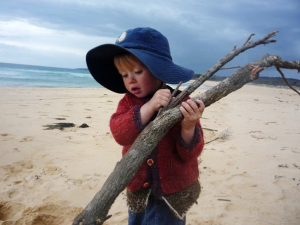
Their motor control is still a little crude; they still stagger in walking, and run headlong without much capacity to slow down or turn corners. They take great delight in, and express themselves through, physical activity like romping and rough-and-tumble play, in dancing, clapping, stamping, or laughter.
Interestingly while they can build a tower of blocks vertically they still cannot rearrange them in a horizontal row. They also have difficulty in making a horizontal stroke with crayon, even though they ‘imitate a vertical stroke with the greatest of ease’. This capacity of whether they can yet combine the vertical and horizontal is interesting to watch in their play and drawing over this whole year.
When eating, they continue to need help in feeding. They may refuse foods. There is very little conversation with meals. They are apt to dawdle and play with food, especially in stirring it. This general tendency to dawdling, not only in eating but elsewhere, can be very irritating to adults but it is helpful to accept that children enter fully into each experience as an exploration. They need time and respect for this. They hate hurrying. When their carers can slow down too and use these moments for mindfulness themselves, it makes the world a better place for children.
At bedtimes, they demand to take toys to bed with them. They usually respond without fussing to being taken to the toilet in the evening. They may be half asleep when taken to bed.
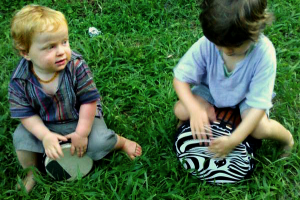
In play, there are less rapid shifts in attention than before. Here too, they show an interest in dawdling, in taking time! They are interested in dolls, teddy bears and beads (strings them, or drops them in holes in tops of boxes only to dump them out again and repeat the process); they transport blocks in the wagon more than building with them. Parallel play (playing “beside” rather than “with” as in true cooperative play) predominates when with other children, though they obviously enjoy being with other children. They have little interest in what other children do or say, but they may hug others or push them out of the way as though they were physical objects, physically snatch and grab, or defend their rights by kicking and pulling hair.
Younger Twos still do not imitate things which they remember, but only those events which are present to their senses and stimulated by the present environment. Their memory, at this stage is a “place memory”’ which relies on sensory cues in the immediate environment to trigger the memory (e.g. seeing the corner field again where the donkey once was seen, triggers the memory of the donkey).
Younger Twos do not ask for help so easily. Carers must be constantly watchful and ready to help without waiting to be asked. When out walking, the children linger over activities along the way, or pick up sticks and stones. The carer has to wait, call to the children or lure them on to some new interest. They may refuse to hold the adults hand except on curbs or walls, which they delight in.
Despite this being an amenable age, under pressure the child is more apt to go in the opposite direction. Even children in relatively cooperative ages need to feel their independence and their autonomy and may react to pressure on them to do things, especially at other people’s pace. Children need an environment which demonstrates that: “Here there is time.” Adults need to draw children along with them, into the “tribe”, into the “we”, into the “togetherness” of “this is the way we do things here”. This helps to avoid threatening the child’s independence by “ego to ego” directives which invite resistance. (“I want you to do this now!”) Adult authority needs to come from within with inner authoritativeness. (“Now we all do this…” “Now the toys go back in the box!”) Adults will need this even more in the next stage of Older Twos to manage the children’s even more intense need for freedom and independence.
Descriptions of the emotional nature and mood of Younger Twos reveal a lot of the qualities which are traditionally associated with the Moon: they have a more quiet good nature, they are more amenable to the flow of things, show more sociability (as development allows at least) with a certain gentleness in social interaction, a love of home, repetition and routine.
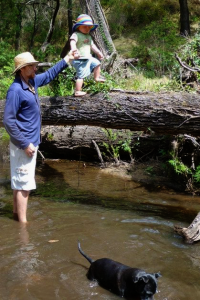
We can see all this in the detailed and sympathetic observations of Younger Twos of Gesell researchers Louise Bates Ames and Frances L. Ilg in Your Two Year Old Terrible or Tender (Dell Trade Paperback, New York 1976) so we quote directly:
‘For many parents Two is the best age of all.’ ‘Emotionally, Two seems much of the time to be comfortable and content. Life feels good to him. Emotions do not take over as they do at some other ages. Two can express his warm affection by his cosy, snuggling ways. There is an easy give and take between parent and child. He now seems comfortable with himself.’ ‘He not only expresses his desires but he wishes to possess, to have things all his own.‘ “It’s mine.” ‘A delightful companion…in the home’, loves doing little errands’, ‘fetching Daddy’s slippers’. Loves walks but ‘loves to come ‘home again’ ’.
‘He knows where things go’. ‘dotes on putting away the canned goods’…’loves to watch all household activities… beginning to take a hand in these himself.’ ‘He delights in imitating and enjoys working side by side with his mother.’ ‘He explores through his senses’. He ‘likes the feeling of having the same thing happen day after day.’ Routines suit him. ‘ “Again” is an oft repeated demand.’ ‘Sequence is important’. ‘Even in eating he is beginning to enjoy repetition.’
In play Two ‘enjoys other children…gently, minimally.’ Interaction is exploratory’, not truly aggressive. The future ‘Two and a half year old type fights over materials do not take place, as one or the other [Two] gives in too easily and too impersonally.’… ‘The balance is very delicate as to who gives in to whom.’ Any grouping remains fluid, behaviour very individual. They ‘love swinging’ and rhythmic activities.
Two is now saying ‘yes’ more.’ …Shows ‘a robust sense of mine, but a very weak sense of thine.’ ‘He can hoard but cannot share.’
As we would expect in a stage with Moon qualities, the behaviour of younger Twos is certainly easier and more enjoyable for adults than the age which follows in Older Twos. Nevertheless, if the children’s needs are not being met, or if they are stressed, they will still show more difficult behaviours, more sleep problems etc. It needs loving observation to get to the source of these and give appropriate support.
This is a good stage for parents to consolidate their loving relationship with, and understanding of, their individual child before the challenges of the next stage set in. There is a danger with the Younger Twos that we take their natural goodness in this stage for granted, especially when there are other children to care for who are in more demanding stages.
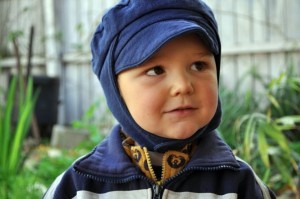
Older Twos: Two Years & 6 months to Three Years
A stage with Mercury qualities
In Older Twos we see qualities and motivations traditionally associated with Mercury: the importance to them of freedom of movement and independence, characteristic mental quickness and sociability, an enthusiastic interest in the world and great difficulties with choice—for they want it all. It is also possible that they may enjoy a little of the confusion they create, just as the older stages with Mercury qualities also do!The stage of Two and a half to Three years is described by Gesell as being ‘in disequilibrium and breaking up’.
The emphasis in physical growth has now moved into the chest and rhythmic system. Gradually over this time we can see new growth in the social sphere, in the imagination and in creative play.
At around two and a half years the children also experience for the first time a new sense of self, and an increasing awareness of their own physical separateness from beloved carers; this can be seen in their increasing awareness of people other than themselves and in their language, as they consolidate their use of the word “I”, versus “me” or “Johnny”. This “coming into themselves” can also be seen symbolically in their drawings as they start to make concentrated points in their scribbling, inward spirals and the cross (the bringing together of the vertical with the horizontal). With this new self-awareness can come deep insecurities which were not there before, new fears of separation while they learn that adults will not abandon them and will indeed come back.
Questions arise in response to feeling separate: ‘Will my parents leave me?’ ‘Will they come back to me?’ ‘Will the things in my life still be here tomorrow?” Fear, and even desperation and terror, can rise up as a result of these new insecurities. We may see these fears in milder ways like their choosing to hold the adult’s hand by choice and their reluctance to leave the adult, despite their strong need for independence. Or these fears may manifest in even more challenging behaviours for adults to deal with, like truly desperate screaming and loss of all control. It is a stressful time with tears, tantrums and confusion and needs considerable understanding.
The potent descriptions of the struggles of Older Twos provided below are from the Gesell Institute’s books on this age Your Two Year Old Terrible or Tender and The Child from Five to Ten by Arnold Gesell, Frances Ilg and Louise Bates Ames (Harper & Row 1974 ). They describe Two and a half as being:
…in ‘disequilibrium’, ‘breaking up’ and ‘…He is reputed to be variously impetuous, imperious, contrary, hesitant, dawdling, defiant, ritualistic, unreasonable, and incomprehensible.’ ‘…especially difficult when violent, demanding, explosive emotions take over…’ an age of exaggerated tensional outlets…thumb sucking…stuttering…scream[ing] and [will] produce temper tantrums on the tiniest provocation.’ ‘a complete despot’. ‘…“no” is a much used word.’ …They may say “no” when they means “yes”…. ‘They may repeat everything said to them. [This type of child has difficulty in comprehending what is asked of him/her.] They elicit the attention of adults. “Look at me.”’
Clearly Older Twos need our help, our deep understanding and protection!
To protect themselves, children of this age set up all sorts of ways to bring stability and predictability into their relationships and environments. They are desperate to be in control. If adults do not understand these needs as being the motivators for the children’s cries for support, then difficult behaviours become more entrenched as the child becomes more desperate.
With their new awareness of self, they inwardly question “what is me? My hair, my hat, my toy, my bed?” Anything that threatens this notion of an extended “me” also causes trouble. They do not want to share, or see their coat or special toy given to another. Gesell researchers describe this: ‘He will bring a favorite toy to nursery school to display it with pride; but he finds he cannot quite surrender it to his playmates. He will also be seized with an intense impulse to acquire a coveted toy; but once in possession, he abandons it with indifference.’
Sharing threatens their new-found sense of self and they can be desperate to defend that. It is wiser to support this need at the time and not worry about their “need to learn to share”. A more appropriate time will come for that. Having separate “sharing toys” and even clothes (spare hats for example) from early on in the child’s life – as distinct from “Tommy’s toys” –can help with this problem.
It is a time when it is helpful to try to meet as fully as possible these needs for routine, security, reassurance, and protection of self, and cut down (it is only for a few months) on all those things that challenge their security and feeling of reasonable control of their life. It helps to stay home, hold to routines, avoid new situations unless led by the child. Put the child first for a few months. It is not a good time to start child care for many! Wait until their sense of security reappears. Remove the stresses and allay their fears and we may find that the more positive qualities associated with Mercury appear; they can be ‘delightful, less resistant’, enthusiastic and sociable.
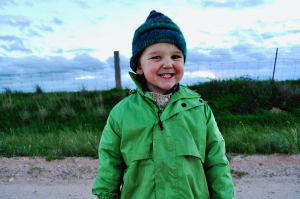
Gesell researchers further describe the child of this age: He ‘demands sameness. He wants everything to always be the same.’ This is a developmental need for predictability in the same way he ‘wants everything to be appropriate—belongings to go with the people they belong to.’ ‘He himself fulfils his need for sameness by setting up elaborate, sometimes amusing, sometimes exasperating rituals to keep himself on the right track…to avoid the conflict of having to make a choice.’ He wants ‘the same route taken, the same order of events in time. By three he will not need the environment to support him in this way. He will be able to permit variety, difference, change.’ Yet at the same time, ‘he does like to explore and investigate.’
These point to another quality associated with Mercury that also causes challenges at this time in Older Twos— the Mercurial need for independence and freedom, and especially the freedom to move, which impacts on decision making. All children want to experience independence and autonomy but in the stages showing Mercury qualities this is even more evident. They demand to do things by themselves even though they may not yet be able to. It also manifests in extremes in behaviour, contrariness and in the resistance to demands from adults which threaten their independence.
Here we also find the quality associated with Mercury that in their ‘vast and enthusiastic interest in all that happens’ they want it all! They do not want to choose between one thing or another, between extremes. They have not yet learned to prioritise, or to wait, or to moderate, or to accept they have to have some things one at a time. No! They want it all at once and they want their independence and not to be limited in their options by other people’s choices and directions.
Gesell research describes this:
‘His difficulties are due to the fact that he is just discovering a new realm of opposites… He has a great deal of intermediating to do between contrary impulses, and yet he has to become acquainted with both opposites. Being inexperienced as well as immature, he often makes two choices where he should make one; or he makes the wrong choice; or he makes none at all. … He has yet to acquire skill in balancing alternatives and in thinking of one alternative to the exclusion of another. He reminds us of the two-way rocking and the creep-crawl stages in the patterning of prone locomotion.’
‘…his direction tends to be the opposite of the way you have directed. Now he has matured to the point where he sets up his own opposites. This is how he finds out about the world—by exploring both of any two extremes in quick succession…a very important part of growing up.’ ‘It is an age when other adults [than the parents] may do better to take over.’
‘He may disrupt parental harmony by pitting Mother against Father. And he can drive everyone to distraction by his insistence that “Mommy do it” when Daddy is taking over, and then that “Daddy do it when Mommy takes hold.’ ‘The person he wants is whatever person is not available at the moment, and if everyone is available, his demand may change to “Me do it myself.”’
So Older Twos have great difficulty with decisions. ‘This is possibly the worst age of any for making choice. Two-and-a-half vacillates back and forth, and if he finally settles for one of two choices, he is almost bound to choose the other immediately’. By his very nature, the child of this age has merely to choose the red one and he wants the blue; to choose yes, and he definitely wishes no.
As we will see with Younger Sixes, it is helpful to minimise either/or choices, and to help the child to see that the having of one thing now does not eliminate the possibility of having the other soon/later. As parents will know, this will not eliminate the problems of getting Older Twos to do something but it may help to minimise them.
In the descriptions of Older Twos below we need to watch for the insecurities arising out of this new experience of ‘self’ and the stubborn contrariness relating to the need for freedom to choose or more accurately, not be made to choose. When not met with understanding, Gesell suggests these behaviours, become entrenched:
‘Met head-on with harsh, unrelenting demands [from adults], a Two-and-a-half-year-old tends to become even more rigid, oppositional, negative, and generally difficult than he might otherwise have been. Met with skill and kindness, with good preschool techniques, with a little bit of humour, even a very demanding boy or girl may be willing and able to give in now and then.’ ‘…for all his rebelling, his stubborn opposition, even the Two-and-a-half-year-old still believes that you, his parents, are all-powerful and all-wonderful.’
‘The two-and-a-half-year-old may be, above all else, imperious, bossy, and demanding…but it helps to remember that the child is bossy not because he is sure, but actually because he is unsure. If he can command even a small part of it [his parents] it helps him to feel secure.’ Yet ‘he is a good deal more wily than the adult realizes, and with his increasing vocabulary and his vast and enthusiastic interest in everything that happens, he is often putting two and two together to a far greater extent than one’s casual observation may make evident.’
This last description is very consistent with Mercury qualities, the wiliness and vast and enthusiastic interest.
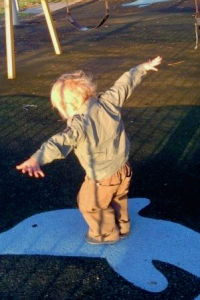
Another clue to helping this age group lies in meeting children’s need for movement which is so characteristic of Mercury. The Gesell researchers say: ‘Almost any restriction of his bodily movements is hard for him to accept, especially when it keeps him from doing something that he wants to do.’ Further, the uninterrupted smooth flowing of their own activities are important to them: ‘Interruptions to his play—which of course come often in daily life— are very real frustrations for him. It may seem to the child that play is constantly interrupted by parental demands that he eat, sleep, go to the bathroom, come into the house.’ Perhaps then it is not so surprising that children can be so contrary in their responses to parental requests, particularly since they are not yet skilled in moderating their social behaviour. Once more the skill of the adult lies in being able to subtly redirect all this in the direction of what the adult needs to happen, without the child having to follow a directive which he or she very likely will want to resist!
In summary, Older Twos want control, show enthusiasm, indecisiveness, and to-ing and fro-ing between extremes (which may have its origins in their wanting it all – in true Mercurial fashion). It seems they also need the freedom to move and play independently, uninterrupted and unobstructed. They need patient understanding even more than the stages before and after which are the more cooperative, amenable ages associated with the qualities of Moon and Venus.
View/download pdf Two
Further reading
Louise Bates Ames and Frances L. Ilg in Your Two Year Old Terrible or Tender (Dell Trade Paperback, New York 1976) . A Gesell Institute for Child Development book Or www.simplicityparenting.com/
Payne, Kim John, with Lisa M. Ross Simplicity Parenting Using the Extraordinary Power of Less to Raise Calmer, Happier and More Secure kids. (Ballantine Books Trade Paperbacks, New York, 2009) Or visit their website: www.simplicityparenting.com
See also
Avoiding trouble with young children
Strategies for healthy living with young children
Healthy play
Possible presents list
Older five and younger six. This article describes the next Mercury stage and gives more detailed examples of ways parents can work with the difficult Mercury behaviours.
Enriching life with children